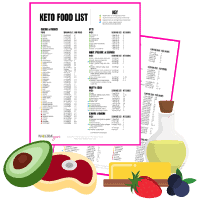
Free Printable: Low Carb & Keto Food List
Get It NowBefore you start converting sweeteners, read my guide about sugar substitutes and keto sweeteners here — it’s crucial for understanding how they work and has a big section on baking. The most common question I get, though, is how to replace sweeteners in keto recipes. So, I created a sweetener conversion chart, as well as an easy calculator to do it for you. I’ll also talk about erythritol substitutes (the most common question), and the recipe differences when using erythritol vs stevia, monk fruit vs stevia, and allulose vs erythritol.
If you’re overwhelmed about which keto sweetener to try first, I highly recommend starting with Besti Monk Fruit Sweetener With Allulose! It tastes and bakes just like sugar, but unlike other brands of monk fruit, it also dissolves and browns like sugar as well. It’s great for a keto diet and you don’t have to sacrifice taste.
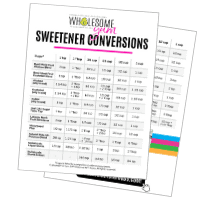
FREE PRINTABLE: SWEETENER CONVERSION CHART
Join 300,000+ others to get a FREE printable conversion chart for keto sweeteners!
GET IT NOWHow To Substitute Sweeteners In Recipes
If you need to replace a sugar-free sweetener, try to replace it with one that has a similar volume and sweetness level, and the same type (liquid, granulated, or powdered). This is the safest way to get a positive end result. Use the sweetener conversion chart or calculator below for the exact amount.
If you can’t, the way to do it will vary depending on the recipe. Here are some general tips:
- To replace a granulated sweetener with a concentrated one, replace that bulk with something else. If you are baking, this would be whatever flour the recipe uses. As long as that flour is not drying (like coconut flour), it should turn out okay. But, you will likely need a little more of the converted amount of concentrated sweetener, to account for the extra (not sweet) flour. If the flour is drying, like coconut flour, you’ll need more liquid as well to compensate.
- To replace a granulated sweetener with a liquid one, add more of the dry ingredients in the recipe to absorb the extra liquid.
- To replace a concentrated sweetener with a granulated one, add more of the wet ingredients in the recipe to balance out the extra bulk from the granulated sweetener.
- Check the section on baking with erythritol for more tips.
Are you seeing the pattern? There are no guarantees when replacing sweeteners of different types. These tips are a guideline, but not guaranteed to work. At least this should give you a general idea.
You want to try to maintain the same consistency of the batter or dough that you are working with, while keeping a similar level of sweetness. It’s not always easy!
Natural Keto Sweetener Conversion Chart
There are various sources out there for converting among sugar-free sweeteners. The problem is that I have yet to see a chart that lists many or most of them in one place, in a concise way. I put together a chart that you can use as your go-to place for sweetener conversion.
Want a printable version of the sugar-free sweetener conversion chart? Sign up below and I’ll send it to you!

FREE PRINTABLE: SWEETENER CONVERSION CHART
Join 300,000+ others to get a FREE printable conversion chart for keto sweeteners!
GET IT NOW| Sugar | 1 tsp | 1 Tbsp | 1/4 cup | 1/3 cup | 1/2 cup | 1 cup |
|---|---|---|---|---|---|---|
| Besti Monk Fruit Allulose Blend | 1 tsp | 1 Tbsp | 1/4 cup | 1/3 cup | 1/2 cup | 1 cup |
| Wholesome Yum Allulose | 1 1/4 tsp | 1 Tbsp + 1 tsp | 1/3 cup | 1/3 cup + 2 Tbsp | 2/3 cup | 1 1/3 cup |
| Erythritol (any brand) | 1 1/4 tsp | 1 Tbsp + 1 tsp | 1/3 cup | 1/3 cup + 2 Tbsp | 2/3 cup | 1 1/3 cup |
| Allulose (any brand) | 1 1/4 tsp | 1 Tbsp + 1 tsp | 1/3 cup | 1/3 cup + 2 Tbsp | 2/3 cup | 1 1/3 cup |
| Xylitol (any brand) | 1 tsp | 1 Tbsp | 1/4 cup | 1/3 cup | 1/2 cup | 1 cup |
| Just Like Sugar Table Top | 1 tsp | 1 Tbsp | 1/4 cup | 1/3 cup | 1/2 cup | 1 cup |
| Lakanto Monkfruit Sweetener | 1 tsp | 1 Tbsp | 1/4 cup | 1/3 cup | 1/2 cup | 1 cup |
| MonkSweet Plus | 1/2 tsp | 1 1/2 tsp | 2 Tbsp | 2 Tbsp + 2 tsp | 1/4 cup | 1/2 cup |
| NuNaturals NuStevia Stevia Extract | – | – | 3/16 tsp | 1/4 tsp | 3/8 tsp | 3/4 tsp |
| Natural Mate All-Purpose Blend | 3/8 tsp | 1 1/8 tsp | 1 Tbsp + 1 1/2 tsp | 2 Tbsp | 3 Tbsp | 6 Tbsp |
| NuNaturals NuStevia Liquid Stevia | 3/8 tsp | 3/8 tsp | 1 1/2 tsp | 2 tsp | 3 tsp | 2 Tbsp |
| Pure Monk | – | – | 1/6 tsp | 1/4 tsp | 1/3 tsp | 2/3 tsp |
| Pyure All-Purpose Blend | 1/2 tsp | 1 1/2 tsp | 2 Tbsp | 2 Tbsp + 2 tsp | 1/4 cup | 1/2 cup |
| Sukrin:1 | 1 tsp | 1 Tbsp | 1/4 cup | 1/3 cup | 1/2 cup | 1 cup |
| Swanson Purelo Lo Han Sweetener | – | 1/4 tsp | 3/4 tsp | 1 tsp | 1/12 tsp | 3 tsp |
| SweetLeaf Sweet Drops Liquid Stevia | – | 1/8 tsp | 1/2 tsp | 2/3 tsp | 1 tsp | 2 tsp |
| Swerve | 1 tsp | 1 Tbsp | 1/4 cup | 1/3 cup | 1/2 cup | 1 cup |
| THM Sweet Blend | – | 1/2 tsp | 2 tsp | 1 Tbsp | 1 Tbsp +2 tsp | 3 Tbsp |
| THM Gentle Sweet | 1/3 tsp | 1 tsp | 1 Tbsp + 1 tsp | 2 Tbsp | 3 Tbsp + 1 tsp | 6 Tbsp |
| Truvia Spoonable | 1/2 tsp | 1 1/4 tsp | 1 Tbsp + 2 tsp | 2 Tbsp + 1 tsp | 3 1/2 Tbsp | 1/3 + 1 1/2 Tbsp |
Keto Sweetener Conversion ChartPin It For Later!
What’s Not In The Sweetener Conversion Chart
The following sweeteners are not in the conversion chart, for these reasons:
- Artificial sweeteners – I do not advocate artificial sweeteners (including sucralose and aspartame), and suggest finding a better low carb natural sweetener option instead. You can read more about it in the Sugar Substitutes article.
- Natural sweeteners that use sugars as bulking agents – Examples of such bulking agents are dextrose and maltodextrin. These raise blood sugar and are often GMOs.
- Natural sugar sweeteners – Granulated natural sugar-based sweeteners (like coconut sugar) can be used 1:1 like sugar, so they require no conversion. Keep in mind they do still raise blood glucose levels. Most other natural sugar-based sweeteners are syrups (such as maple syrup, honey, agave, etc.), which are also excluded for the reasons below.
- Keto liquid sweeteners and syrups – These are excluded because they do not easily convert from granulated table sugar. The liquid aspect would require other modifications to be made to a recipe using table sugar. This can sometimes be true for converting among various granulated sweeteners as well, but not as often as when converting between granulated and liquid.
- Confectioners and brown sugar replacements – These are obviously specialized for certain uses, so there isn’t a point to convert regular sugar to them. They are not included in the sweetener conversion chart.
You can still read about these sweeteners and their sweetness level compared to sugar in my Sugar Substitutes post.
Sweetener Conversion Calculator
I also created a calculator that does the work for you, so you don’t have to figure it out from the sweetener conversion chart!
Just bookmark this page to have the keto sweeteners calculator handy anytime you need it…
Keto Low Carb Sweetener Conversion Calculator

FREE PRINTABLE: SWEETENER CONVERSION CHART
Join 300,000+ others to get a FREE printable conversion chart for keto sweeteners!
GET IT NOWComparing The Most Common Sweeteners
You can learn about what the most common keto-friendly sweeteners are and how they work in baking in my Sugar Substitutes post, which is why I recommend reading that first. But below are specific comparisons people ask about the most. All of them are keto friendly, but there are differences in their sweetness and baking properties.
Erythritol vs. Stevia
Erythritol and stevia are totally different, but there are some commonalities because of how stevia is typically sold:
- Erythritol is a sugar alcohol derived from corn via fermentation, whereas stevia extract comes from stevia leaves and has a very concentrated sweetness from the stevia plant.
- Erythritol is 70% as sweet as sugar. Stevia is 100 to 300 times as sweet as sugar. This makes plain erythritol easier to use than plain stevia.
- Stevia can have a bitter aftertaste, especially in its pure form. Erythritol has very little to no aftertaste, but may show a mild cooling effect, similar to mint.
- Both erythritol and stevia have 0 glycemic index, 0 calories, and 0 grams net carbs.
- Many brands of stevia are actually blended with erythritol to make a 1:1 sugar substitute. These will have similar properties to plain erythritol, but sweeter. However, some brands of stevia are pure extract (very concentrated) and some 1:1 brands are blended with maltodextrin or dextrose instead (these are other names for sugar — not good).
Monk Fruit vs. Stevia
Monk fruit and stevia have more in common than erythritol and stevia do:
- Like stevia extract, monk fruit extract comes from a plant and is very concentrated — about 150 to 400 times sweeter than sugar. This means you need only a very small amount of them to make a recipe sweet, but they can be difficult to use for this reason.
- Also like stevia powder, monk fruit based products tend to be mixed with other sweeteners or bulking agents. This is in part because pure monk fruit extract is hard to come by and expensive, but also because blending makes monk fruit easier to use.
- Both monk fruit and stevia extracts come in powder or liquid form when you buy them concentrated. They can be part of granulated sweetener blends, though.
- Both monk fruit and stevia have 0 glycemic index, 0 calories, and 0 grams net carbs.
- In contrast to stevia, monk fruit extract has less bitter aftertaste. This makes it a good choice for people sensitive to the aftertaste of stevia.
Allulose vs. Monk Fruit vs. Erythritol
Allulose, erythritol, and monk fruit are all pretty different from one another, but monk fruit is often blended with erythritol or (less commonly but far superior) with allulose.
- Because monk fruit extract is hundreds of times sweeter than sugar and difficult to use on its own, most brands of monk fruit are blended with erythritol and will have erythritol-like properties. However, Besti Monk Fruit Allulose Blend is blended with allulose instead, so will have (much more desirable) allulose-like properties.
- Allulose and erythritol have the same sweetness (70% as sweet as sugar), and both have a pleasant taste, with no bitterness. They are equivalent on the sweetener conversion chart.
- Erythritol has a slight cooling sensation, whereas allulose does not.
- Even though allulose and erythritol have similar sweetness, they are structurally very different. Allulose is a rare sugar (in the same family as glucose, lactose, etc.) so it actually tastes and acts like sugar, but because we can’t metabolize it, it still has 0 grams net carbs. Erythritol is a polyol (sugar alcohol), so it behaves less like sugar.
- Erythritol, like other sugar alcohols, is more likely to cause stomach upset than allulose. Monk fruit on its own does not cause this either, but brands of monk fruit that contain erythritol (as most have) can.
- Allulose is excellent at locking in moisture, which means it creates moist, soft baked goods. Erythritol tends to be more drying. Pure monk fruit extract is neutral.
- Allulose browns, caramelizes, and dissolves like sugar. Erythritol does none of these things. Adding monk fruit to either of them does not change how they behave.
- Erythritol (and erythritol blends of monk fruit) can crystallize, leading to a gritty texture. Allulose and pure monk fruit extract do not.
- Monk fruit, erythritol, and monk fruit all have 0 calories, 0 grams net carbs, and 0 glycemic index.
Erythritol vs. Xylitol
Erythritol and xylitol are both sugar alcohols, so they are in the same structural family. They are similar but have some key differences:
- Erythritol is 70% as sweet as sugar, whereas xylitol measures 1:1 with sugar.
- Erythritol has 0 glycemic index, but xylitol has a slightly elevated glycemic index of 7. This is still very good compared to table sugar, which has a glycemic index of 65, but is less ideal for keto or diabetics.
- Xylitol does not have the cooling aftertaste that erythritol has, and in general tastes more similar to sugar than erythritol does.
- Erythritol is less likely to cause gastrointestinal distress than xylitol (or other sugar alcohols), because most of it gets absorbed in the small intestine (but is poorly metabolized [*]) and is later excreted unchanged into the urine. All other sugar alcohols, including xylitol, reach the large intestine instead, where they may lead to stomach pain, bloating, or diarrhea. But, erythritol can still cause stomach issues for some people.
- Xylitol is lethal to dogs [*], so people with dogs may prefer not to have it in the house.
- Erythritol has 0 grams net carbs. Because xylitol is partially absorbed, about 1/4 of the total carbs should be counted as net carbs (1 gram per teaspoon serving).
Natural vs. Artificial Sweeteners
You can read more about artificial sweeteners and why I don’t recommend them in my Sugar Substitutes post.
Erythritol Substitute Options
If you want an erythritol substitute, consider the following options:
- Sweetener blends – These are usually designed to measure 1:1 with sugar, which is very convenient. Most brands of monk fruit and stevia are actually erythritol blends, so they will behave the same way, but they are sweeter. If you are replacing erythritol in a recipe with a 1:1 blend, use 3/4 cup of the blend for every 1 cup of erythritol. (Or use 1 1/3 cups erythritol to replace each cup of the blend if converting in the other direction.) The sweetener conversion chart and calculator above make this easy to do. Monk fruit allulose blend will have the same conversion, but will yield better, more allulose-like results (see the Allulose vs. Monk Fruit vs. Erythritol section above).
- Allulose – The best erythritol substitute in my opinion! In fact, most of the time the results are even better, since allulose dissolves and browns better.
- Xylitol – This won’t solve the issue if you can’t tolerate sugar alcohols, but works if you just ran out of erythritol.
- Pure Monk Fruit Or Stevia – These are very concentrated without being part of a blend, so only recommended for recipes where the bulk aspect of sweetener isn’t needed, such as drinks. Avoid substituting them for erythritol in keto baking.
Pinterest-Friendly Sweetener Conversion Chart
The above natural low carb sweeteners chart can be helpful, and I hope you’ll bookmark this page to refer back to it. Another convenient way to save the conversions is to use this Pinterest-friendly image:
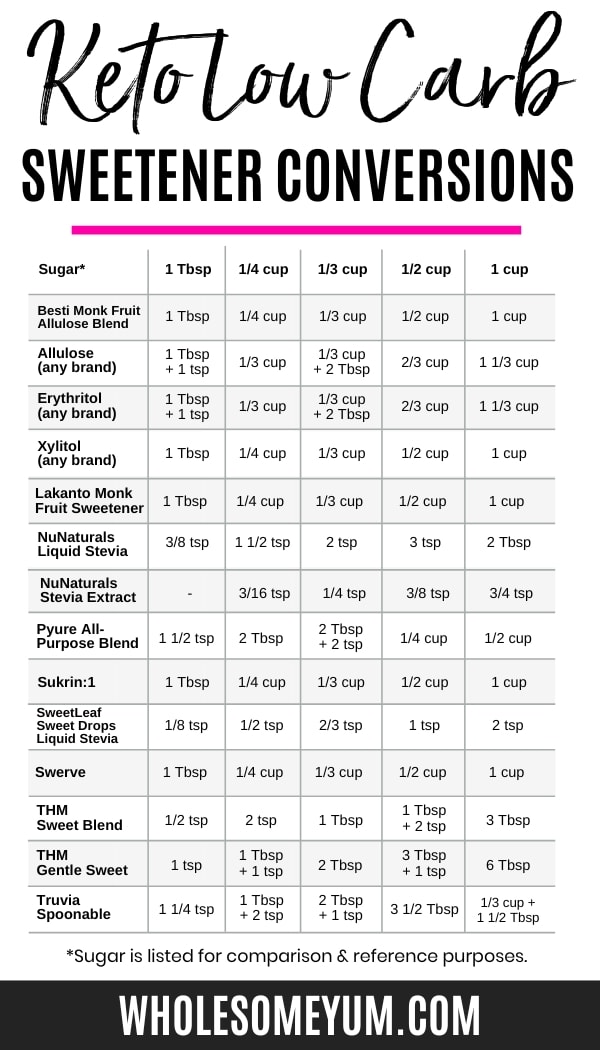
Keto Sweetener Conversion Chart

FREE PRINTABLE: SWEETENER CONVERSION CHART
Join 300,000+ others to get a FREE printable conversion chart for keto sweeteners!
GET IT NOW My
My Shop
Shop Wholesome Yum
Wholesome Yum
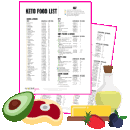


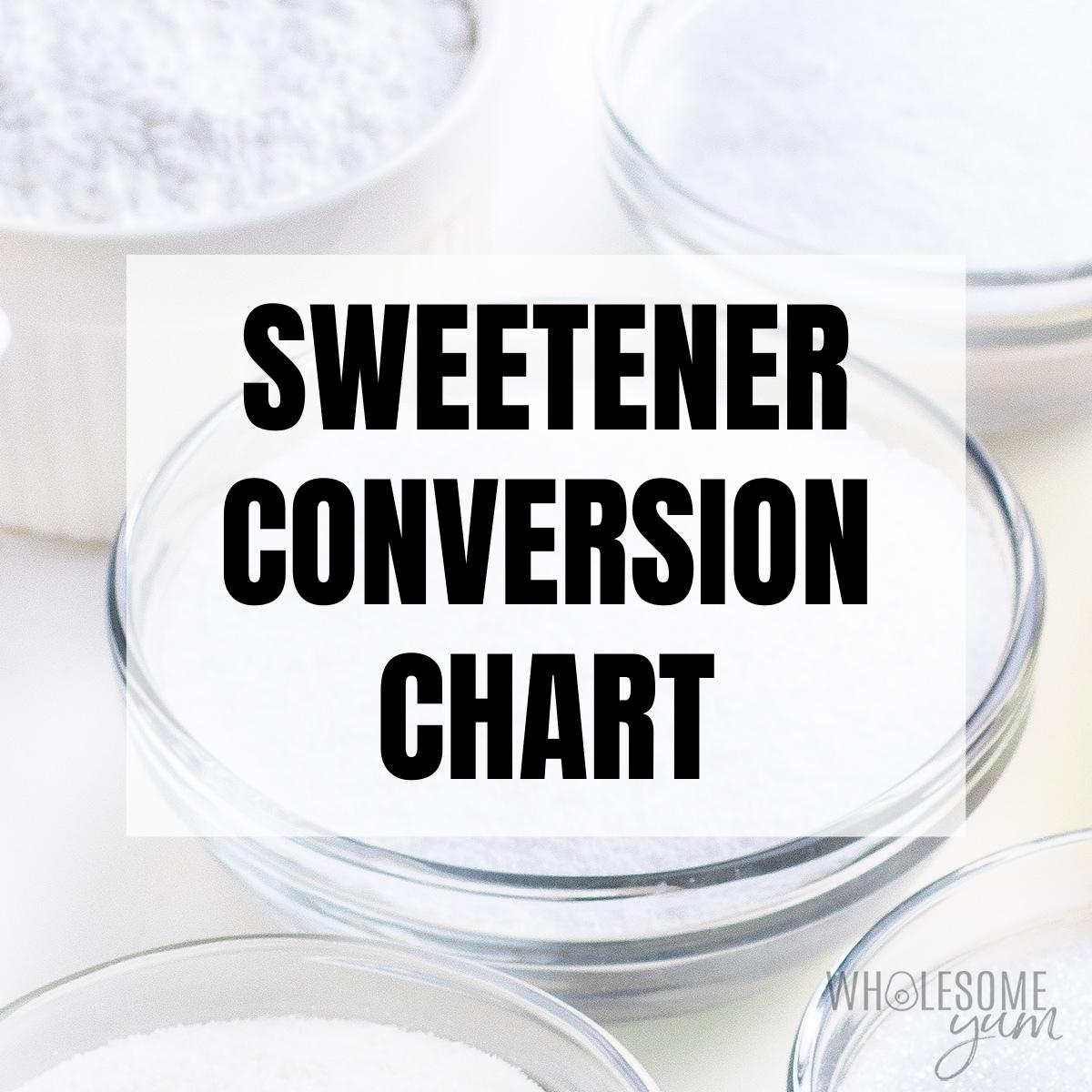





334 Comments
Kathy
2You should have a print button so we don’t have to go through all of this stuff!
Wholesome Yum D
0Hi Kathy, You can access this in printed form in the members area of the site.
Sara
1Hello, thank you for the super clear explanation on sugars. I’m curious about inulin (chicory root) which I believe can also be used as a substitute and also has the added advantage of increasing our fibre intake. If you’ve any thoughts on how to integrate this, would be super to know. Thank you.
Sara
Melody Ellerby
0So I bought some sugar free white chocolate baking chips to make a recipe with coconut flour (1/4 cup) with almond flour (2 cups) and it’s a cookie recipe. I don’t have 1 cup erythritol/stevia blend sweetener, so what should I use? I might have to resort to caster sugar or white sugar until I get to the store to buy the right sweetener.
Wholesome Yum D
0Hi Melody, You can use the conversion chart and input the sweetener that you have a available to you.
Elaine
0I have a few keto books. Sometimes it won’t give me a specific type of sweetener. It will just say ” keto approved granular” or “keto approved powdered”.
I purchased the allulose brands for both. But what should I use in the conversion calculator to determine how to convert those “types” with the allulose ones?
And when it does give me a specific type, such as xylitol, does it matter the brand name of xylitol I use in the conversion caluculator?
Thanks! I’m allergic to stevia in every form. I haven’t found an amazing type of “sugar” substitute that I love. Sadly I still LOVE Sweet and Low in my morning coffee. And I KNOW it’s terrible!
Wholesome Yum D
0Hi Elaine, There are several brands listed in the conversion chart but if the brand you have isn’t listed you can just use the generic allulose.
Victoria Gross
0I do all the cooking for my sister. She has joined your Keto program. Just got the pills yesterday. She has asked me to get familiar with the program so that I can cook for her. I have no problem with the changes to my kitchen. HOWEVER, i have no idea as to where to get these sugar substitutes like Besti. The herbs are easy. I will try the almond or coconut milk when I go shopping.
Maya | Wholesome Yum
0Hi Victoria, I don’t sell (or recommend) any pills for keto. They are not necessary and usually a gimmick. You can learn more about starting keto here and all you need are the right foods. You can find Besti sweetener here. Hope this helps and good luck to your sister.
Brenda
0Looking for a conversion .1/4 Liquid allulose (not available in Canada)to stevia or another natural sweetener for baking
Wholesome Yum D
0Hi Brenda, You can purchase Wholesome Yum Simple Syrup in Canada.
Dennis Crapse
0My biggest question is, if the recipe calls for packed brown sure, do I also pack the Besti Brown? What is the weight conversion between the Besti Sugars and their respective sugars?
Wholesome Yum D
0Hi Dennis, Yes, you can pack Besti Brown. You can change the recipe card from US customary to metric to get the measurements in grams.
jack halley
0Thanks for the post! I have used Lakanto Monkfruit Sweetener in a mousse recipe but I do not want to use Erythritol any more in my mousse. So I found some brands such as “it’s just” or “teakihut” which are pure monkfruit without erythritol. How much of the pure monkfruit should I use to be equivalent to using 1/3 cup of Lakanto Monkfruit Sweetener (which has erythritol)? ThX!
Maya | Wholesome Yum
0Hi Jack, Pure monk fruit isn’t a great replacement for blends, as it’s bitter on its own and very concentrated, so you’d only need a tiny amount for the same sweetness but swapping for equivalent sweetness would throw off the consistency in most recipes. I recommend using Besti instead, which measures 1:1 with other monk fruit blends, contains no erythritol, and won’t throw off your recipes.
DG
0Thanks so much for this! I was just reading up on the differences between erythritol and stevia on another site and landed on stevia as my best option, but maaaaan it’s hard to convert stevia for recipes! You have no idea how much I’m going to use this chart. Thank you!! ❤️
Maiko
0I’m so excited to have found you! I am completely new to the sugar substitutes game! I just purchased a bag of Xylitol only because I saw it mentioned somewhere but I may send it back. I’ve always been so afraid of anything “sugarfree” because I’ve heard it linked to causing cancer. I am trying to be low-carb, but am really missing baking and having something sweet on occasion. If you were to suggest one sweetener that is safest and best to start with, which one would you suggest? It’s a bit overwhelming but your site seems so thorough. Thank you!!
Wholesome Yum D
0Hi Maiko, Besti is natural sugar substitute tastes, bakes, browns, and dissolves just like sugar does, and produces soft, moist baked goods.
Janet
0I have a recipe that calls for liquid allulose. I would like to replace it with liquid stevia or sucralose. I am assuming the the allulose in your chart is granulated, not liquid. Do you know how much liquid stevia or sucralose you would substitute for 1 cup of liquid allulose?
Wholesome Yum D
0Hi Janet, You can read more about liquid sweetener here.
yvonne
0I never knew there were so many kinds of sweeteners! This is so helpful to make healthy choices.
Is there an easy way to know how to convert between sweeteners instead of just sugar? I have started using your allulose and allulose blend but some of my recipes call for stevia and swerve. I really don’t want to keep a lot of sweeteners around.
Wholesome Yum D
0Hi Yvonne, You can use the conversion chart in post to convert different sweeteners.
A
0Why isn’t regular stevia on the list?
Wholesome Yum D
0Hi, There is more information on stevia in my Sugar Substitutes Guide.
Rita
0Is keto good for people with diabetes type 1 and those who have their bladder removed?
Wholesome Yum D
0Hi Rita, Usually a keto diet is recommended for diabetics but I suggest you consult with your doctor.
Emma
0Thank you. I just bought pure monk and it’s super sweet! I’ll try your conversion rate next time I’m baking.
Margarida
0Why coconut sugar is not on the list?
Wholesome Yum D
0Hi Margarida, Coconut sugar is not a keto sugar alternative.
Jana
0Super